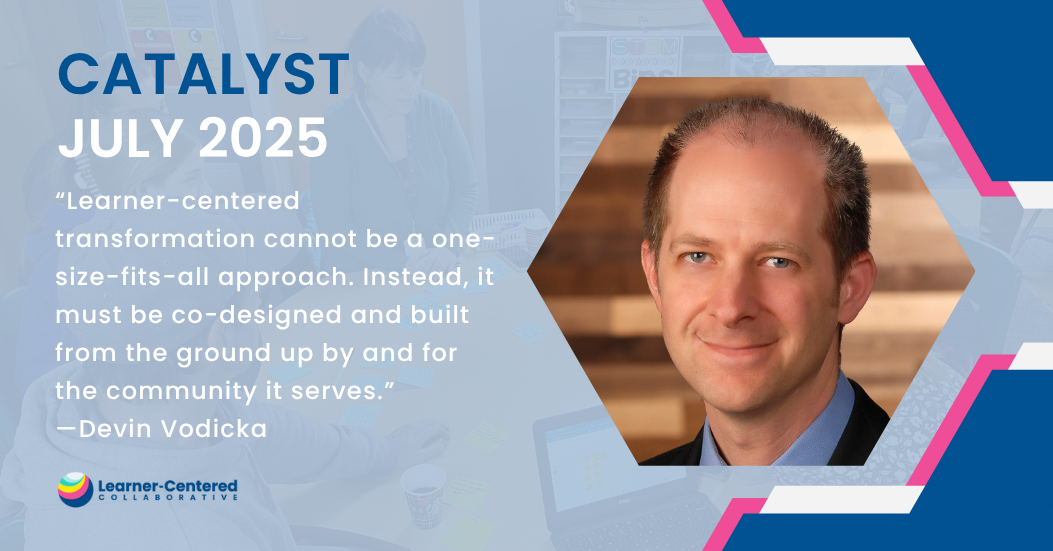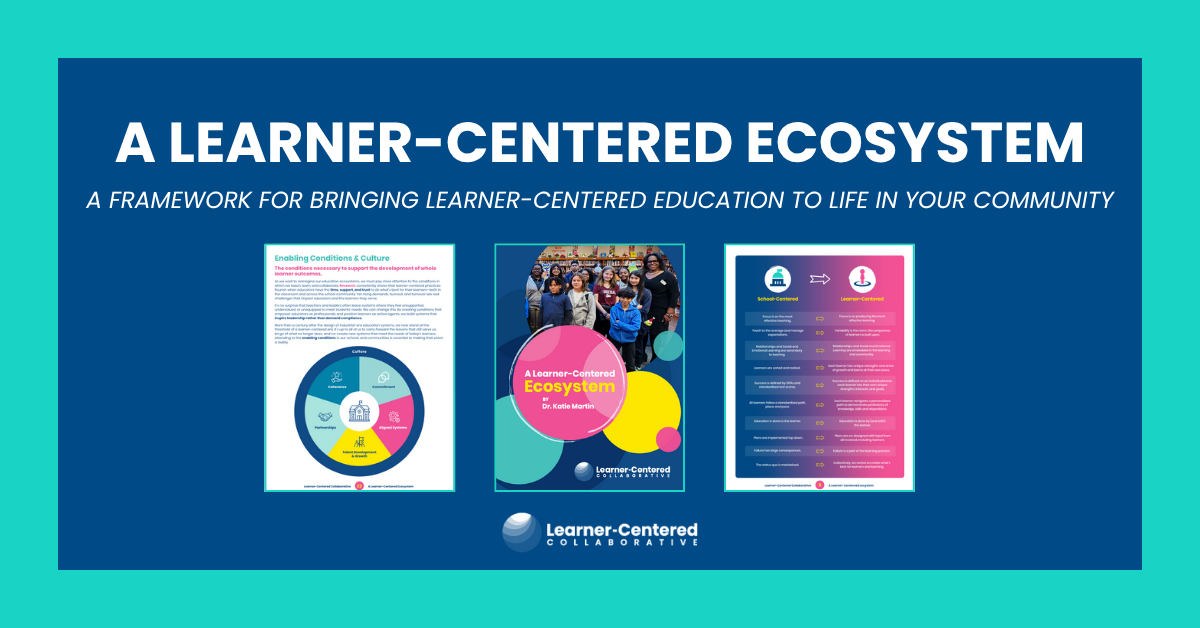How You Can (Almost) Have It All With AI: Optimizing the Balance of AI and Human Interaction
Written in collaboration with Brittany Griffin, Director of Strategic Partnerships
There’s ample buzz around AI’s potential in K-12 education. It ranges from excitement, to concerns around ethical dilemmas, to debates about the efficacy of learning in front of a screen, to fear that technology will replace educators. Some have called for an all-in adoption of AI, while others have banned it outright. Almost every technology platform (including leading LMS and SIS tools) has started to advertise how they are currently leveraging AI.
So, how can educators and leaders make decisions about when and how to use AI? There are two variables that are often in tension with one another: efficiency versus the value of human interaction. These two variables can be helpful guardrails when determining how AI can best serve you, your classroom, school, and/or district.
Balancing Efficiency and Valuable Human Interaction
Adam Grant said “Cognitive skills are what elevate us above animals. Character skills are what elevate us above machines.” In this article, Vriti Saraf shows that there are certain tasks that AI can do better and faster than humans, and others that require the nuance, creativity, and empathy of a human.
When considering whether to use AI, start with 2 questions:
- What efficiencies will AI provide?
- How much value comes from human interaction? In other words, what connection or other value would I lose by using AI?
If you had a magic wand, what would you unlock using AI in education? Hear LAUSD Director of Instructional Technology Initiative Sophia Mendoza and LCC’s Brittany Griffin had to say about this and more in our webinar: Supercharge Learning: Unlocking the Learner-Centered Power of AI.
When to use (and not use) AI
✅🤖 Use AI: Green Zone
The “green zone” is the space where human interaction doesn’t necessarily add value, but efficiency does. It’s a no brainer to use AI for these scenarios. Educators have long used AI & technology to accomplish things like resource curation, text generation, and data analysis to save them hours of work. This could look like using a tool like Diffit to create 3 different levels of a reading text with comprehension questions for a science lesson.
✔️🤖 Leverage AI to increase capacity for human interaction: Yellow Zone
For time intensive tasks where human interaction adds significant value, AI can be used for portions of those tasks to free up time and capacity for human interaction. This is the “Yellow Zone”. An educator might use an adaptive math software to help learners get math practice at their own level. While learners are working independently on their personalized math practice, the educator pulls small groups of students to do mini lessons, interventions and math games. In this scenario learners are benefiting from the human interaction of their group, the personal attention and support of their teacher, and the personalized, just right, math practice that the technology provides. Meanwhile, the educator benefits by not having to create 30 different math practice worksheets and has time to individually work with each learner.
❓🤖 Maybe use AI: Orange Zone
Other tasks live in the “orange zone” where efficiency is not found but there is no loss of valuable human interaction in leveraging AI. Many people start tinkering with AI in the orange zone. This could look like asking ChatGPT to rewrite an email in a different tone. Time is not necessarily saved and the email is already a digital tool where human interaction is not lost by leveraging AI.
❌🤖 Should NOT use AI: Red Zone
In the “red zone” are tasks where human interaction is irreplaceable. Even as AI tool capacities expand, there is value in honoring our humanity and our ability to create meaningful relationships and connections. This could look like morning meetings and calling families to celebrate a learner achieving a goal. These are moments where human interaction is the value and an AI tool can’t replace an educator in these tasks.
Have a task in mind that may or may not be a contender for AI? Use our When to Leverage AI Tool to help you evaluate if AI can play a beneficial role.
As with any technology of past, present, and likely future too, valuable human interaction, connection, and relationships take precedence over efficiency. We also have an opportunity to double down on valuable human interactions by finding where technology can make us more efficient and thus create more time and space for valuable human interactions.
AI Saved Time. Now What?
Let’s explore a few examples of the valuable growth and learning that can happen when AI unlocks more time for connection and human interaction.
Assessment
For decades, we have been using technology to make assessment more efficient (think Scantrons of yesteryear, Poll Everywhere, and computerized tests of today) and AI only increases this ability. Tools leverage AI to give specific math feedback to learners that goes beyond whether they got the answer right or wrong. In a recent webinar we shared a high school English example about a teacher who is using AI for formative first draft essay feedback, which in turn allows for more time to conference with learners and teach targeted lessons based on common needs. If we value the true purpose of assessment, which is to sit beside and help the learner learn, we can see that there is a value in human interaction during assessment opportunities, particularly through conferencing conversations with learners and when evaluating performance assessments and portfolios. If the way of the future is a more holistic picture of student success and assessment, we must develop systems that support assessment as learning practices, which can be enabled by intentional use of technology.
In this example…
🤖What is AI doing? Assessing and providing feedback on selected responses and written response assessments
🧠 What is the human doing? Providing quality feedback through conferencing and supporting portfolio collection
Analyzing Survey Data
Although AI is highly skilled at ingesting large amounts of data and synthesis, there is still value in some data—particularly the qualitative kind, to pass through a human, empathetic filter. For example, if multiple students shared the same idea in a survey but used different or local terms, AI has no way of picking up the nuance when analyzing. However, a teacher reading that survey data might notice the pattern given their additional context. How might you leverage AI for some data analysis such that it frees up your time to focus on that data that requires a human touch?
In this example…
🤖What is AI doing? Evaluating quantitative data and summarizing free response questions
🧠What is the human doing? Using local context and understanding to make meaning of AI’s analysis and findings
Ready to explore AI in your context? Check out our Learner-Centered AI Course.
Ultimately, your AI use depends on your context. Next time you try AI, we urge you to ask yourself what level of efficiency you are gaining and how much value from the human interaction you might be giving up. If you decide to leverage AI, think about what you will do with that valuable time. Does it free you up to spend more 1:1 time with the students that need it most? Or write a more personalized statement on each students’ report card narratives? Or call more community partners to create that really cool project where students will be interacting with different organizations?
Technology, AI, and Learner-Centered Education
At Learner-Centered Collaborative, we believe strongly that thoughtful, purposeful use of technology and AI in education is a key enabler of learner-centered education. We also know they are best leveraged in environments that emphasize authentic, competency-based, inclusive and equitable learning. This requires that educators commit time to get to know their learners, build community, create opportunities for collaboration and authentic problem-solving while providing choices to learners based on their needs and interests. In a learner-centered environment, relationships are paramount and the focus is on developing whole-learner outcomes in addition to content knowledge and skills. It can be incredibly difficult and time-consuming to create learner-centered learning experiences by hand; AI is a tool that should be leveraged so long as it ultimately leads to efficiency and valuable human interaction.
How might AI help you create more learner-centered learning experiences for students? Get in touch with our team to discuss.









